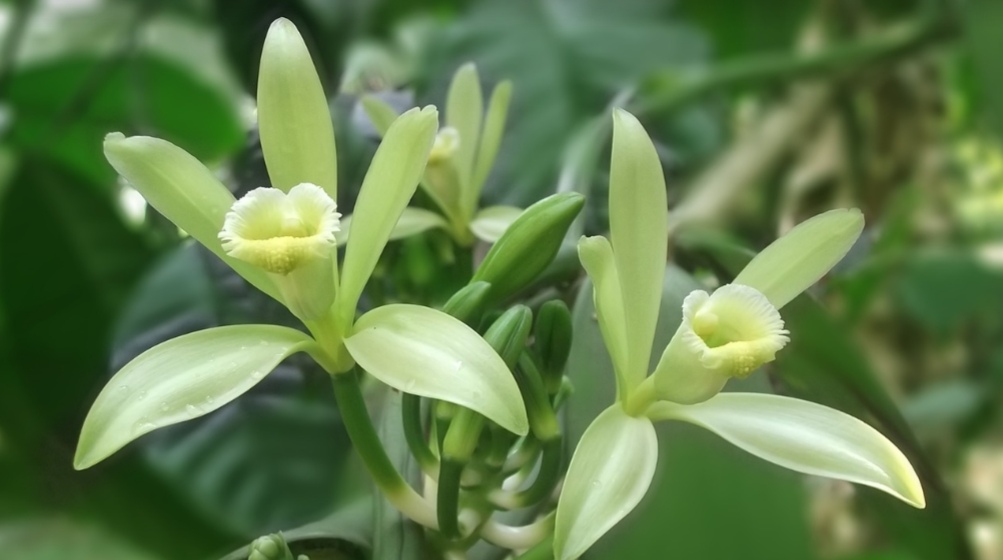
Tonga
Vanilla
Vanilla planifolia

General Description / Cultural Significance
Tonga, a Polynesian kingdom spread across more than 170 islands in the South Pacific, is renowned for its vibrant cultural traditions and close relationship with nature. Among the plants that play a central role in Tongan life are the vanilla orchid (Vanilla planifolia), and the heilala plant (Garcinia sessilis).
Since the late 19th century, the vanilla orchid has held immense economic and cultural significance for the nation. Vanilla production in Tonga is deeply intertwined with local traditions and sustainable farming practices. Vanilla orchid cultivation plays a large role in local communities where it thrives with skilled care in Tonga’s warm temperatures, high humidity, and well-drained soil.
The cultivation of vanilla is a labor-intensive process that is often done by hand due to the lack of natural pollinators in Tonga. The vanilla pods that grow from the orchid take several months to mature. Once harvested, the pods undergo a lengthy curing process to develop the distinct aroma and flavor that makes vanilla so prized in global markets. This intricate process has positioned vanilla as one of the most valuable crops in Tonga, with global demand for natural vanilla significantly outstripping supply.
Vanilla production in Tonga is not just an economic activity but a deeply cultural one. The Tongan people have traditionally relied on the land for sustenance, with agriculture being central to daily life and societal structure. Vanilla farming fits within this broader context, where cultivation practices are often passed down through generations. Families and communities work together to tend to the vanilla orchids and beans, fostering a sense of unity and pride. For many Tongan farmers, particularly those in rural areas, vanilla provides a vital source of income and a path toward economic independence.
In traditional Tongan medicine, infusions or extracts from vanilla beans are used to soothe upset stomachs or aid in digestion, and for its antioxidant, inflammatory, and antioxidant qualities to treat different conditions.
A plant that is native and integral to Tongan culture is the heilala (Garcinia sessilis). Revered for the beauty of its bright red or pink flowers, the symbolic value of purity and grace, and its multifaceted uses, Tongan representatives have said that “just as the monarchy is one thing that makes Tonga unique, so is the heilala plant. Many think that in the hierarchy of Tonga flowers, the heilala flower is the highest.”
There are male and female plants with only the female flowering. The tree is difficult to propagate and must be closely nurtured to survive. The heilala flowers, used in ceremonies and festivals, are extremely small measuring only about one centimeter in circumference but emit a powerful distinct sweet fragrance. The heilala flower is used in making garlands for royalty and dancers for special occasions. To prevent the flower from wilting after being made into a garland, salt water is sprayed on which also brings out the fragrance of the flower.
Traditional Tongan medicine is rooted in the use of native plants, and the heilala holds medicinal value that has been utilized by Tongan communities for generations. Tongan healers have long used parts of the plant to treat various ailments, reflecting a deep knowledge of the island’s natural resources. The new leaves of the heilala tree, which are red before turning green, are an important ingredient in many traditional medicinal potions. The bark is boiled the make anti-inflammatory extracts. The traditional uses of Heilala oil to heal the skin now becoming broadly popular.
Climate Change / Conservation Status
Tonga faces unique environmental challenges due to its geographic location, low-lying topography, and reliance on natural ecosystems. Tonga’s islands, especially the smaller and more remote ones, are losing land area which is leading to the displacement of populations and the destruction of homes, infrastructure, and cultural sites. Community-based adaptation efforts are also taking place in Tonga, with a focus on improving agricultural practices, enhancing water storage and management, and restoring ecosystems such as coral reefs and mangroves. Both the vanilla orchid and the heilala plant are tied to the future of Tonga itself as the country navigates environmental changes and seeks to balance natural and cultural preservation with economic development.
Despite its potential, vanilla farming in Tonga faces several challenges. Climate change is one of the most significant, with rising temperatures, changing rainfall patterns, and the increased frequency of extreme weather events threatening vanilla crops. Vanilla orchids are sensitive to environmental changes, and even slight disruptions in temperature or humidity can affect their growth and productivity. This poses a serious risk to the livelihoods of Tongan farmers who rely on vanilla as a primary source of income.
The future of vanilla cultivation in Tonga will depend on the country’s ability to adapt to environmental and economic pressures. Sustainable farming practices, such as agroforestry and organic farming, are becoming increasingly important in ensuring the long-term viability of vanilla crops. Agroforestry, the practice of growing vanilla orchids in the shade of larger trees, mimics the vanilla plant’s natural environment and can help protect the crop from extreme weather while preserving soil health. This method not only benefits vanilla production but also contributes to biodiversity conservation and carbon sequestration, helping Tonga combat the effects of climate change.
Collaboration with scientific communities and agricultural experts can further enhance the resilience of Tongan vanilla farming, particularly in the face of climate change. It’s also important that the heilala will remain a cherished and vital part of Tongan society. As Tonga faces the challenges of climate change and modernization, the heilala and the vanilla orchid stand as reminders of the importance of preserving cultural and natural resources for future generations.
Alternate Names
Flat-leaved vanilla
West Indian vanilla
Vanilla bean
Orchidaceae
Sources
Consul General, Tonga Consulate General, San Francisco, CA

